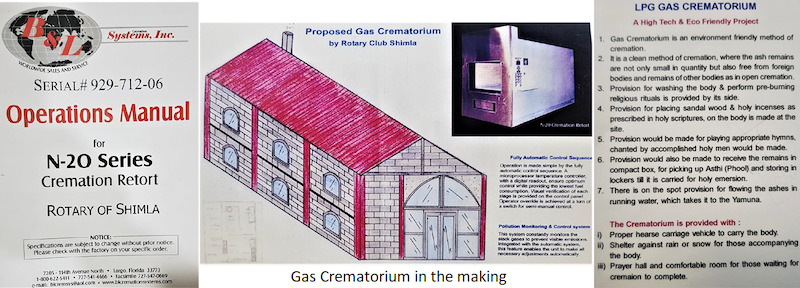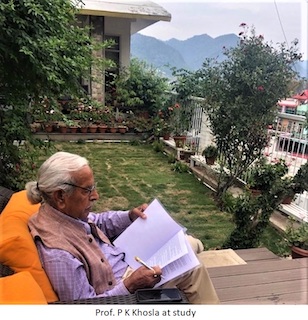
‘The death of a person or two is a tragedy. When many people die, those are statistics’. Josef Stalin
Crematoriums and cemeteries are running out of space; people are helplessly changing rituals for their dead as Covid-19 rages and the world looks on in horror.

The crematorium at Kanlog near Shimla is overbrimming. The covid infected corpses are being cremated as also the non-Covid dead. “It’s difficult to handle the rush because it takes four to five hours to cremate a body donning the personal protection equipment (PPE) kit”. The traditional crematory is located near a mystic waterfall; a conglomerate of Bamloe Nala and sewerage from Nirankari Bhawan.
- Way back in 1998-99, Rotary Club of Shimla joined hands with ‘Jan Kalyan Vikas Samiti – Khalini & Kanlog’ followed by Phagli, Nabha & Ramnagar areas to evolve the heritage pyres into a full-fledged crematorium.
The site was earmarked around the existing pyres. The Environment wing of the HP Forest Department granted permission to change of the ‘land use’.
‘Vikas Mein Jan Sehyog’, Government of Himachal Pradesh, extended ‘Grant in Aid’ to this urban feature to the extent of 25%; admissible up to50% for Rural areas.
- Mr. Umesh Akre, the then Chairman, Rotary Crematorium Committee, keenly led the mission.
- Er. I D Garg, his acquaintance, volunteered to assist him in meeting the challenge of channelizing water from the fall; and also involved his son who did structural designs of thereof the Prayer Hall and other two structures alongside traditional pyres. Foundation for the Prayer hall is 30’ below the ground with a wood go down in between.
- The surfacing of the human skulls, during excavation, scared away the labour. The design thus took a tilt towards a split-level construction. To make space for the new sheds, rock blasting was executed with the help of the Himachal PWD.
- Notwithstanding a hand pump, a freshwater MC connection from a height of 400~500 ft was released without tariff. The 4000 liters capacity tanks were put in a position to break the pressure. Last but not the least, the source now provides an ‘elixir of life to the people, in the vicinity, in times of need and scarcity.
In the meantime, an idea was mooted to install a gas crematorium below the Himachal High Court building, but to materialize at its present location at Kanlog.
- A specially designed furnace, suiting Indian rituals (asthian), was imported from America. Unfortunately, two years warranty period lapsed in customs custody. With the upper parts rusted, the 15 tons heavy plant reached the destination by trailer with an inbuilt crane. Simultaneously, a structure to house 60 domestic gas cylinders was erected. An extra length for Chimney had to be procured from Parwanoo. Additional voltage stabilizers, to obtain 100 Amps current to initiate the computerized electronic system, had to be put in position, courtesy Himachal Electricity Board. With no installation fee, but travel expenses of the Engineer to and from Florida, USA; the gas crematorium was ultimately commissioned in 2004.
- To begin with some unclaimed corpses were being cremated by the Corporation. A few local residents had been trained to operate the plant. A corpse with a coffin over a make-shift bier of bamboos is moved manually on a trolley into the furnace; where it is warmed up at 750 degrees Celsius before it is reduced to ashes. It takes about 1.5 hrs for burning and another hour for cooling.
- The project raised by The Rotary Trust is now run by the local Sood Sabha. Donations, however, qualify for due exemptions under the Income Tax Act.
‘People preferred wood for the last rites hence it lay in disuse for a long time and developed a snag. The Sood Sabha has now sought the government’s help to fix the gas-operated crematorium.’
- “To my wife’s question if Coronavirus was a living or non-living thing’- my response was, ‘is both!’ They cannot replicate on their own, but need living cells of a ‘host’ for this purpose.
Coronavirus is very similar to the Spanish Flu which affected almost one-third of the world’s population between 1918 and 1920. Our experience of the pandemic shows that with time the new mutants lose their lethal effect. Therefore, till such time the number of infected cases drop significantly and they are successfully isolated, we need to avoid unnecessary social contact, especially with infected patients or with those who have been in their close proximity.
A story from Shiv-Puranas provides a hint for Indian scientists to examine the medicinal qualities of the Tulsi plant in order to find a defense mechanism or a possible cure against coronavirus.
Today, most of the stress in the world is due to negativity and fear. In my opinion, meditation is the only way forward!” says Prof. PK Khosla in his Autobiography-Trysts with Karma.
…………………………………………………………………………………………………………………………………………………………………
With inputs from:
Mr. Umesh Akre-An Indian Philanthropist
Prof.(Dr.) PK Khosla, Chancellor, Shoolini University, Solan H P
Prof. (Er.) Chander P Mahajan is an art critic & a free lance journalist. The Environmentalist stays in Shimla and Dalhousie, Himachal Pradesh, India.





